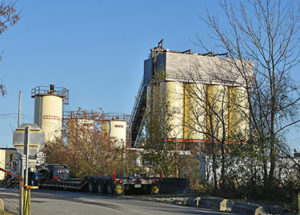By Beth David, Editor
PJ Keating is disputing that a recent bylaw change created the industrial district and codified operations at the South Main Street site.
The company wrote in an email:
“There has been an asphalt plant operating on the property continuously since the 1950’s, including in the current location. The change to the zoning bylaw that took place in approximately 2017 did not change the industrial zoning status of the property, which permits operation of the asphalt plant. That zoning change only impacted the maximum structure height (which was increased to help The Acushnet Company add silos for their golf ball operations), meaning that PJK would not need a height variance for the plant. The top of tanks that are barely visible from outside the P.J. Keating property, out over the top of the far left of the building, are for liquid asphalt storage and are currently not being used.”
At a special town meeting on 11/14/16, the only change to 3.3.5 Industrial District I-1, did indeed allow the height of structures to change.
The bylaw added a section, as follows:
“(f) Buildings for industrial purposes related to sand and gravel processing may increase from thirty-five (35) feet at a rate of one (1) foot of height for every one (1) foot of distance from the required setback to a maximum of 70 feet”
The Neighb News spoke with several town officials that recall a bylaw change that created the industrial district.
Before the change, the property was “pre-existing, non conforming,” said Acushnet Building Commissioner Jim Marot.
Online Town Meeting warrants go back to 2015, and the Neighb News could not find the change that created the Industrial District.
The section of the bylaw that allows the use is “3.35 I-1 Industrial District (I-1), and specifically allows mining and quarry operations, rock crushing, hot mix asphalt operations, and ready mix concrete operations.
Mr. Marot said that before the industrial district was created, the company had to go before various boards for permission to make a variety of changes in operations and to the property.
The way the law reads now, the use is a “by-right use,” a term used during the latest discussions by town officials and town counsel.
The assertion that the top of the banks are “barely visible,” is true of the photo that was used in our 11/11/21 issue. However, another photo taken that day from just a few hundred yards north from the sidewalk across the street, clearly shows the silos and the tanks visible from the street.
BELOW: This is the photo that ran on the cover of our 11/11/21 issue, when we referred to the “silos,” which store asphalt, as ”tanks,” which store liquid asphalt (but are not operational yet). The silos are the eight structures in to the right of the photo; to the left, one tank can be seen over the top of the buildlng. BOTTOM: This photo was taken farther north on South Main Street, from the sidewalk across the street near the L&S entrance, which abuts the PJ Keating property. Here, the three asphalt tanks are on the left, with the eight silos to the right of them, all clearly visible from the road. Photos by Beth David taken on 11/9/21.

The asphalt plant, with its huge tanks, at PJ Keating Company on South Main Street in Acushnet is in the front of the property, closer to the street and closer to residences than when the asphalt operation was in the back of the property, and the move has prompted complaints from neighbors about increased dust and an acrid stench in the air. Photo by Beth David.

This photo was taken farther north on South Main Street, from the sidewalk across the street near the L&S entrance, which abuts the PJ Keating property. Here, the three asphalt tanks are on the left, with the eight silos to the right of them, all clearly visible from the road. Photo by Beth David taken on 11/9/21.
•••
Click here to download the entire 11/25/21 issue: 11-25-21 Shopping
Support local journalism, donate to the Neighb News with PayPal



